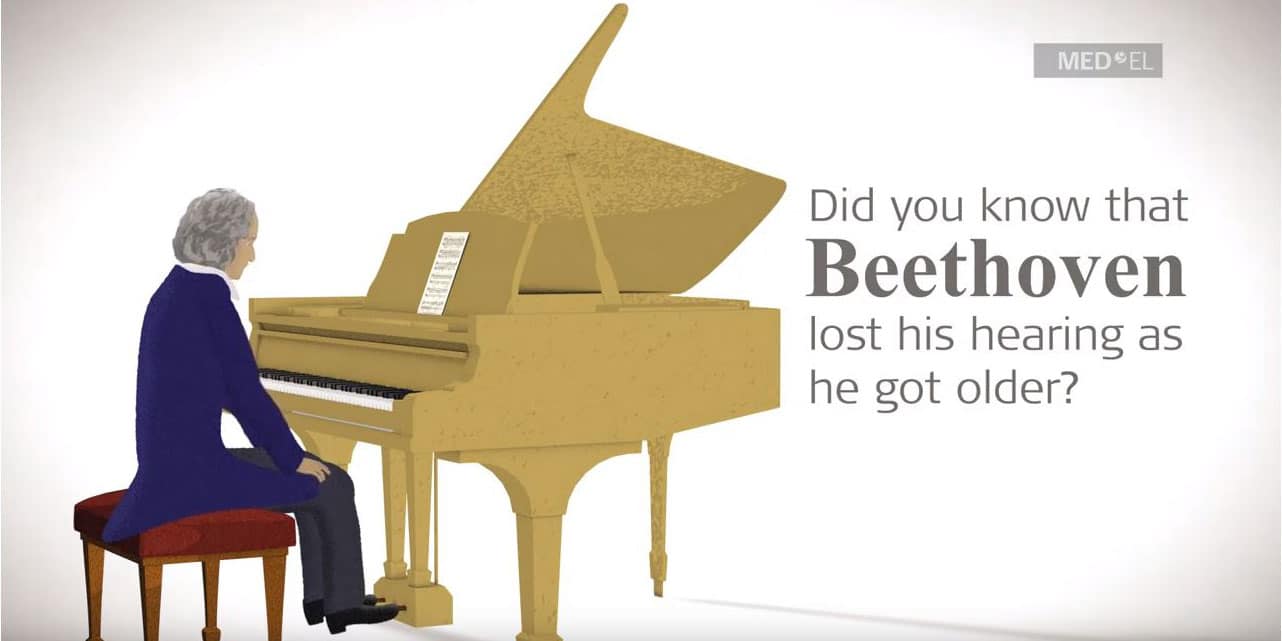MED-EL
Published Feb 13, 2019
From Beethoven To Elephants: How Bone Conduction Helps The World To Hear

Most people learn about how hearing works at school. Sound vibrations go into your ear canal, vibrate your eardrum and the three ossicles in your middle ear, and then reach your cochlea. From here, they are turned into electrical signals and sent to the brain, allowing you to hear. Simple.
But this is only half the story. Sound vibrations don’t only reach your cochlea via your ear, but also via the bones of your skull. This is called bone conduction, and it’s pretty amazing! Read on to find out how bone conduction not only allows deaf people to hear, but is also used by elephants and underwater divers!
How Does Bone Conduction Work?
But first, a quick overview of how bone conduction works. As we said, bone conduction works by sending sound vibrations through the bones of our skull to our cochlea. The sounds around us make the skull bones near our cochlea vibrate a tiny bit. We may not be able to feel these vibrations, but our cochlea can. It picks them up and sends them to the brain as electrical signals, allowing us to hear the sounds.
If you’re wondering what bone conduction feels like you can test it out right now—just cover your ears and speak out loud. See how you’re still able to hear your own voice, even with your ears covered? That’s because the vibrations of your voice are sent through your skull bones and some of them are perceived by your cochlea, allowing you to hear.
Bone Conduction Helped Beethoven To Write Symphonies
The concept of bone conduction has been around a long time. One of bone conduction’s early adopters was the composer Ludwig van Beethoven. Beethoven started to lose his hearing in his twenties and needed a way to hear his music so that he could continue composing.
So he came up with a novel idea. He put a rod into his piano and put the other end between his teeth. The vibrations from the piano traveled down the rod, through his teeth and skull to his cochlea. That allowed Beethoven to hear enough to continue composing, and some of his greatest works were actually written when he already had severe hearing loss!
Bone Conduction Hearing Aids Allow Deaf People To Hear
In the 1970s, scientists and engineers discovered you could use bone conduction to make hearing aids for people with conductive hearing loss. If you have conductive hearing loss, you cannot hear properly as the sound vibrations are not able to reach your cochlea through the ear. That might be because there’s a problem with your ear drum or middle ear, or it could even be that you don’t have an ear canal at all.
But unlike with some other types of hearing loss, people with conductive hearing loss can still hear via bone conduction, and many wear a bone conduction hearing aid. This is a small device worn behind your ear, which picks up the sounds around you with a microphone, and then vibrates the bones in your skull to send the sounds to your cochlea.
There are lots of different types of bone conduction hearing aids, including implants like BONEBRIDGE and non-surgical devices such as ADHEAR. But all of them have one goal: allowing people with conductive hearing loss, mixed hearing loss, or single-sided deafness to hear again.
Bone Conduction Keeps Soldiers Safe
It’s not just people with hearing loss who use bone conduction to hear. Soldiers on the battlefield often use bone conduction headsets to receive their military commands. Why? Because that means they can hear their instructions via bone conduction, but can also still hear enemy gunfire and other danger through their ears as normal.
These headsets have become so sophisticated that they can now be integrated into soldiers’ helmets. The helmets have a special bone conduction receiver, which presses onto the skin behind the soldier’s ear, and vibrates to transmit the sound to the skull bones.
And for the last couple of years this technology has been made available for civilians too (minus the helmet). Bone conduction headphones are the hot new thing, and are ideal for running or cycling, where you want to hear your music, as well as the oncoming traffic!
Bone Conduction Helps Divers Communicate
If you’ve ever done a diving course, you’ll have learnt a variety of hand signals for communicating underwater. But a fancy new piece of tech uses bone conduction to allow divers to both hear and talk underwater.
A bone conduction device can be attached to your diving goggles, pressed against the side of your head. When you talk, the microphone picks up the vibrations from your bone and converts these to ultrasound signals. The ultrasound signals are sent through the water to your partner’s receiver, where they are turned back into vibrations, and sent through their bone to their cochlea. Pretty cool, huh?
Bone Conduction Lets Elephants Hear Sounds A Mile Away
Ever wondered how elephants talk to each other? The answer is, you guessed it, bone conduction! During mating season, a female elephant will stomp on the ground to let the male elephants know she is around. The vibrations from her stomps travel through the ground, and then through the male elephant’s feet and bones, all the way to his cochlea. Male elephants can pick up the vibrations from a female several kilometers away!
What’s more, many elephants will put their trunk on the ground while listening for mating calls. Scientists believe this could help the elephant to locate the source of the sound, by using triangulation between their trunk and their front two feet. Who needs GPS when you have an elephant?
MED-EL
Was this article helpful?
Thanks for your feedback.
Sign up for newsletter below for more.
Thanks for your feedback.
Please leave your message below.
Thanks for your message. We will reply as soon as possible.
Send us a message
Field is required
John Doe
Field is required
name@mail.com
Field is required
What do you think?
© MED-EL Medical Electronics. All rights reserved. The content on this website is for general informational purposes only and should not be taken as medical advice. Contact your doctor or hearing specialist to learn what type of hearing solution suits your specific needs. Not all products, features, or indications are approved in all countries.
MED-EL
.png)


